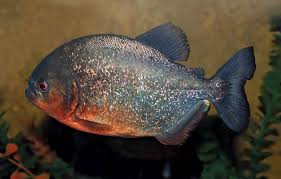
Piranha
Conditions of detention
Piranhas require a large, well-maintained aquarium to thrive. A minimum tank size of 75 gallons is recommended for a small group of piranhas, though larger tanks are preferable, especially as they grow. They prefer water temperatures between 74-82°F (23-28°C) and slightly acidic to neutral water with a pH range of 6.0 to 7.5. Piranhas are schooling fish, so they should be kept in groups to reduce stress, but their tank should provide plenty of hiding spots with rocks, driftwood, and plants to create a natural environment that mimics their native habitat.
Useful Fact: Piranhas are best kept in a species-specific tank due to their aggressive tendencies, particularly when feeding or stressed.
Nutrition and diet
Piranhas are carnivorous and require a diet rich in protein. In captivity, they should be fed a variety of foods, including high-quality pellets designed for carnivorous fish, as well as live or frozen foods such as shrimp, fish, and insects. They can also be given raw meats like chicken or beef heart, but these should be offered sparingly to avoid water quality issues. It’s important to avoid overfeeding, as piranhas can produce a significant amount of waste.
Useful Fact: While piranhas are carnivorous, they are primarily scavengers in the wild, so providing a varied diet that mimics their natural feeding habits is important for their health.
Health
Piranhas are generally hardy fish but can be susceptible to common freshwater diseases such as ich, fin rot, and bacterial infections, particularly if water quality is poor. Stress from improper tank conditions or aggressive tankmates can also lead to health issues. Regular monitoring of water parameters and maintaining a clean environment are essential to keeping piranhas healthy.
Useful Fact: Piranhas can live for up to 10-15 years in captivity with proper care, making them a long-term commitment for aquarists.
Grooming and care
Piranhas do not require traditional grooming, but their environment needs regular maintenance. Due to their messy eating habits, frequent water changes (about 25-50% weekly) and strong filtration are necessary to maintain water quality. It’s also important to remove any uneaten food promptly to prevent it from decomposing and fouling the water.
Useful Fact: Piranhas are shy and can be easily stressed by sudden movements or changes in their environment, so it’s important to maintain a stable, calm tank setting.
Education and training
Piranhas are not typically trained, but they can learn to recognize their owners and may come to the front of the tank during feeding times. However, they are generally more reclusive than other fish and may hide when approached. It’s important to handle them carefully and avoid causing unnecessary stress.
Useful Fact: Piranhas are sensitive to changes in their environment and can become stressed if there are too many disturbances around their tank.
Toys and entertainment
Piranhas are not known for playing with toys, but they do appreciate a well-decorated tank that includes hiding spots and areas to explore. Providing a naturalistic environment with rocks, driftwood, and plants can help reduce stress and encourage natural behaviors. They also benefit from a tank setup that mimics their natural river habitat with subdued lighting and gentle water flow.
Useful Fact: Piranhas are more active during feeding times, so providing a varied and engaging feeding routine can stimulate their natural hunting instincts.
Safety
Piranhas have sharp teeth and powerful jaws, so they should be handled with caution. It’s important to use tools like nets or containers when moving them and to avoid placing hands in the tank, especially during feeding. Piranhas should be housed in a secure tank with a tight-fitting lid to prevent accidents.
Useful Fact: Piranhas are best kept alone or in species-specific groups to avoid aggression toward other tankmates, especially during feeding times.
Accessories
Essential accessories for a piranha tank include a high-capacity filter to handle their waste production, a heater to maintain stable water temperatures, and a secure tank lid. Piranhas appreciate a tank with plenty of hiding spots created by rocks, driftwood, and plants. Dim lighting and gentle water movement also help mimic their natural environment.
Useful Fact: Piranhas are sensitive to bright light, so providing subdued lighting or using floating plants to diffuse light can create a more comfortable environment for them
Socialization
Piranhas are social fish but are also known for their aggressive tendencies, particularly when stressed or during feeding. They are best kept in groups of their own kind, typically 4-6 individuals, to distribute aggression and reduce stress. It’s important to provide enough space and hiding spots to allow for a natural hierarchy to develop.
Useful Fact: Keeping piranhas in a group can help reduce individual stress and aggression, but overcrowding should be avoided to prevent territorial disputes.
Travel and Transportation
When transporting piranhas, use a large, secure container with plenty of water from their tank. Due to their sharp teeth and strong jaws, it’s important to minimize stress and handle them carefully. Ensure the container is well-oxygenated and kept at a stable temperature during transport.
Useful Fact: Piranhas can become highly stressed during transport, so it’s crucial to acclimate them slowly to their new environment upon arrival to prevent shock.
Behavior and psychology
Piranhas are known for their powerful bites and carnivorous diet, but in captivity, they are generally shy and reclusive, especially when not feeding. They prefer to stay hidden among rocks and plants, emerging primarily during feeding times. Piranhas are also known for their schooling behavior, and while they can be aggressive, this is often overstated; they are more likely to flee than attack when threatened.
Useful Fact: Despite their fearsome reputation, piranhas are actually quite shy and will often retreat to hiding spots if they feel threatened or stressed.
Legal aspects
In some regions, owning piranhas is restricted or regulated due to their potential impact on local ecosystems if released into the wild. It’s important to check local laws and regulations before acquiring piranhas. In areas where they are legal, it’s essential to ensure they are sourced from reputable breeders.
Useful Fact: Some states and countries have specific regulations regarding the ownership of piranhas, so it’s important to research local laws before acquiring them.


